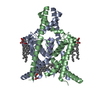[English] 日本語
 Yorodumi
Yorodumi- PDB-8k1j: Human TWIK-related acid-sensitive potassium channel TASK3 at pH 7... -
+ Open data
Open data
- Basic information
Basic information
| Entry | Database: PDB / ID: 8k1j | |||||||||||||||
|---|---|---|---|---|---|---|---|---|---|---|---|---|---|---|---|---|
| Title | Human TWIK-related acid-sensitive potassium channel TASK3 at pH 7.4,200 mM KCl | |||||||||||||||
 Components Components | Potassium channel subfamily K member 9 | |||||||||||||||
 Keywords Keywords |  MEMBRANE PROTEIN / Acid-sensitive / MEMBRANE PROTEIN / Acid-sensitive /  potassium ion channel / C-type / gating mechanism potassium ion channel / C-type / gating mechanism | |||||||||||||||
| Function / homology |  Function and homology information Function and homology informationTWIK-releated acid-sensitive K+ channel (TASK) / Phase 4 - resting membrane potential / stabilization of membrane potential / potassium ion leak channel activity / outward rectifier potassium channel activity / potassium ion import across plasma membrane /  potassium channel activity / potassium ion transmembrane transport / potassium ion transport / potassium channel activity / potassium ion transmembrane transport / potassium ion transport /  synaptic vesicle / synaptic vesicle /  plasma membrane plasma membraneSimilarity search - Function | |||||||||||||||
| Biological species |   Homo sapiens (human) Homo sapiens (human) | |||||||||||||||
| Method |  ELECTRON MICROSCOPY / ELECTRON MICROSCOPY /  single particle reconstruction / single particle reconstruction /  cryo EM / Resolution: 3 Å cryo EM / Resolution: 3 Å | |||||||||||||||
 Authors Authors | Chen, S. / Lin, H. | |||||||||||||||
| Funding support |  China, 4items China, 4items
| |||||||||||||||
 Citation Citation |  Journal: To Be Published Journal: To Be PublishedTitle: Human TWIK-related acid-sensitive potassium channel TASK3 at pH 7.4,200 mM KCl Authors: Chen, S. / Lin, H. | |||||||||||||||
| History |
|
- Structure visualization
Structure visualization
| Structure viewer | Molecule:  Molmil Molmil Jmol/JSmol Jmol/JSmol |
|---|
- Downloads & links
Downloads & links
- Download
Download
| PDBx/mmCIF format |  8k1j.cif.gz 8k1j.cif.gz | 113.2 KB | Display |  PDBx/mmCIF format PDBx/mmCIF format |
|---|---|---|---|---|
| PDB format |  pdb8k1j.ent.gz pdb8k1j.ent.gz | 86.2 KB | Display |  PDB format PDB format |
| PDBx/mmJSON format |  8k1j.json.gz 8k1j.json.gz | Tree view |  PDBx/mmJSON format PDBx/mmJSON format | |
| Others |  Other downloads Other downloads |
-Validation report
| Arichive directory |  https://data.pdbj.org/pub/pdb/validation_reports/k1/8k1j https://data.pdbj.org/pub/pdb/validation_reports/k1/8k1j ftp://data.pdbj.org/pub/pdb/validation_reports/k1/8k1j ftp://data.pdbj.org/pub/pdb/validation_reports/k1/8k1j | HTTPS FTP |
|---|
-Related structure data
| Related structure data |  36793MC M: map data used to model this data C: citing same article ( |
|---|---|
| Similar structure data | Similarity search - Function & homology  F&H Search F&H Search |
- Links
Links
- Assembly
Assembly
| Deposited unit | 
|
|---|---|
| 1 |
|
- Components
Components
| #1: Protein | Mass: 31173.238 Da / Num. of mol.: 2 Source method: isolated from a genetically manipulated source Source: (gene. exp.)   Homo sapiens (human) / Gene: KCNK9, TASK3 / Production host: eukaryotic plasmids (others) / References: UniProt: Q9NPC2 Homo sapiens (human) / Gene: KCNK9, TASK3 / Production host: eukaryotic plasmids (others) / References: UniProt: Q9NPC2#2: Chemical | ChemComp-Y01 / #3: Chemical | ChemComp-K / #4: Water | ChemComp-HOH / |  Water WaterHas ligand of interest | Y | |
|---|
-Experimental details
-Experiment
| Experiment | Method:  ELECTRON MICROSCOPY ELECTRON MICROSCOPY |
|---|---|
| EM experiment | Aggregation state: PARTICLE / 3D reconstruction method:  single particle reconstruction single particle reconstruction |
- Sample preparation
Sample preparation
| Component | Name: CHS / Type: COMPLEX / Entity ID: #1 / Source: RECOMBINANT | |||||||||||||||
|---|---|---|---|---|---|---|---|---|---|---|---|---|---|---|---|---|
| Source (natural) | Organism:   Homo sapiens (human) Homo sapiens (human) | |||||||||||||||
| Source (recombinant) | Organism: eukaryotic plasmids (others) | |||||||||||||||
| Buffer solution | pH: 8 | |||||||||||||||
| Buffer component |
| |||||||||||||||
| Specimen | Conc.: 0.8 mg/ml / Embedding applied: NO / Shadowing applied: NO / Staining applied : NO / Vitrification applied : NO / Vitrification applied : YES : YES | |||||||||||||||
| Specimen support | Grid material: GOLD / Grid mesh size: 200 divisions/in. / Grid type: Quantifoil R1.2/1.3 | |||||||||||||||
Vitrification | Instrument: FEI VITROBOT MARK IV / Cryogen name: NITROGEN / Humidity: 100 % / Chamber temperature: 281.15 K |
- Electron microscopy imaging
Electron microscopy imaging
| Experimental equipment |  Model: Titan Krios / Image courtesy: FEI Company |
|---|---|
| Microscopy | Model: FEI TITAN KRIOS |
| Electron gun | Electron source : :  FIELD EMISSION GUN / Accelerating voltage: 300 kV / Illumination mode: FLOOD BEAM FIELD EMISSION GUN / Accelerating voltage: 300 kV / Illumination mode: FLOOD BEAM |
| Electron lens | Mode: BRIGHT FIELD Bright-field microscopy / Nominal magnification: 81000 X / Nominal defocus max: 2500 nm / Nominal defocus min: 1500 nm Bright-field microscopy / Nominal magnification: 81000 X / Nominal defocus max: 2500 nm / Nominal defocus min: 1500 nm |
| Image recording | Electron dose: 50 e/Å2 / Film or detector model: GATAN K3 (6k x 4k) |
- Processing
Processing
CTF correction | Type: PHASE FLIPPING AND AMPLITUDE CORRECTION | ||||||||||||||||||||||||
|---|---|---|---|---|---|---|---|---|---|---|---|---|---|---|---|---|---|---|---|---|---|---|---|---|---|
| Symmetry | Point symmetry : C2 (2 fold cyclic : C2 (2 fold cyclic ) ) | ||||||||||||||||||||||||
3D reconstruction | Resolution: 3 Å / Resolution method: FSC 0.143 CUT-OFF / Num. of particles: 571806 / Symmetry type: POINT | ||||||||||||||||||||||||
| Refine LS restraints |
|
 Movie
Movie Controller
Controller


 PDBj
PDBj






